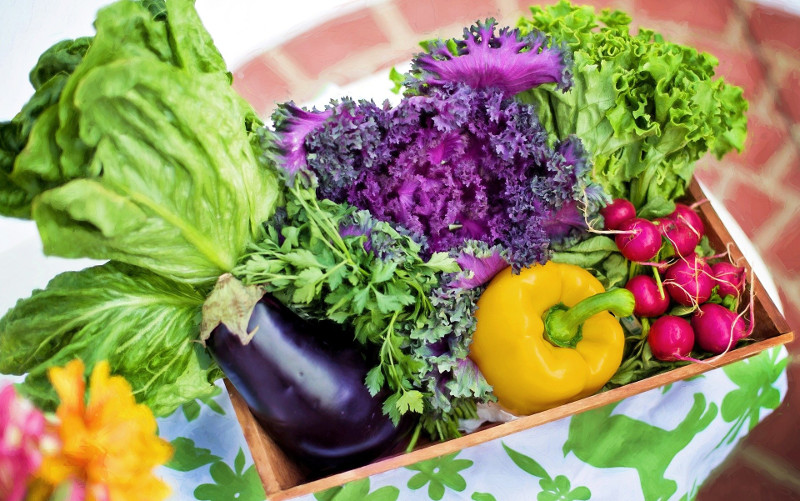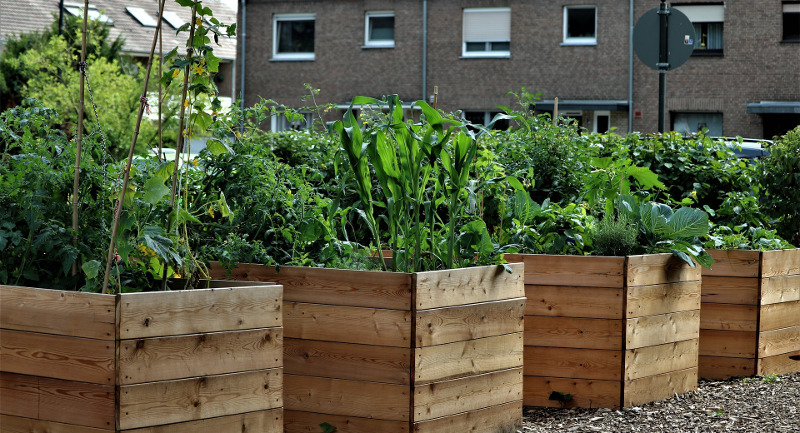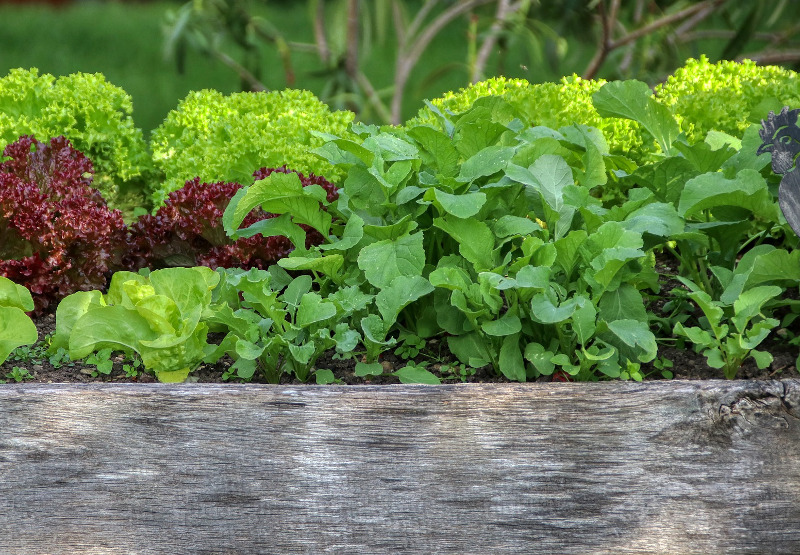Square foot gardening was started in 1975 by Mel Bartholomew. He retired, bought a place in the country and decided to try gardening. Quickly, he became frustrated by the number of weeds that took over his garden. He asked himself many questions including the following questions;
Why Do You Need Three Foot Wide Aisles Between Rows?
People told Mel that this was so that you have room to till the weeds. The square foot gardening method eliminates the uncovered aisles where weeds grow. Therefore, there's no need to waste time and effort weeding those areas.
Why Plant A Long Row Of The Same Crop?
Followers of the square foot gardening method only grow as much as they can eat at harvest time. They plant less and stagger plantings so every plant of a single variety doesn't ripen at once.

Why Plant Seeds Thickly & Then Thin The Seedlings After They Germinate?
In the square foot gardening method seeds are planted at their ultimate spacing. This eliminates unnecessary thinning and wasting seeds.
Why Improve The Soil & Water Areas That You'll Be Walking On?
In the square foot gardening method, raised garden beds are a maximum of four feet wide on each side. Most people can only reach two feet without being off balance. The growing space will never be walked on and compacted when the square foot gardening method is used. Mel and the members of his community garden tried these square foot gardening techniques and were quite pleased with the results. Over many years of teaching and experimenting with his square foot gardening concept, Mel has made several improvements including the ones listed below.
- Build Up - Build raised beds to eliminate amending your existing soil. Beds are usually constructed from wood, but you can also use bricks or concrete blocks. Do not use pressure treated wood or boards that have been painted on the inside.
- Raised Bed Height - Only six inches is needed for most crops. Construct one foot tall beds for long carrots and potatoes.
- No Fertilizer Needed -Mel's Mix contains all the nutrients plants need to grow. You only need to add compost each time you replant a square.
- Aisles - Leave 3 or 4 feet between each raised bed for easy access with a wheelbarrow or harvest basket.
- Grids - Wooden grids are best. You can also use old plastic mini blinds to create an inexpensive grid. Without a 1 by 1 foot grid, it's not a square foot garden.

Sizing Your Square Foot Gardens
The first thing you need to do is determine how many square foot gardens you'll need to feed yourself and your family. Mel has determined that a single 4 foot square garden will provide salad for one adult every day of the harvest season and a second garden of the same size will provide enough daily vegetables for that same person. You will need to add a third bed per person if you plan on preserving or giving away some of your harvest. A 3 foot square garden will provide the same nutritional needs for a child, but children quickly become hungry teenagers. It's best to plan ahead for your children's growing appetites.
Factors in Selecting a Location
Use the following guidelines to determine the best spot for your square foot garden(s).
- Near Your House - The more often you pass by your garden, the more likely you'll take care of it. One of the reasons that traditional row gardens placed in the back corner of the yard become overloaded with weeds is because you never notice them until it's too late. You'll also be more likely to notice when vegetables ripen as you regularly walk by.
- Sunshine - Choose location(s) that receive between 6 and 8 hours of sunshine a day. Plants that produce fruit such as tomatoes, eggplant, squash, pepper and cucumbers need more sunshine than lettuce, kale and other leafy greens.
- Keep Away From Trees and Shrubs - Not only do they provide unwanted shade, but their roots will be attracted to your perfect well watered growing medium.
- Drainage - Keep your gardens out of areas where water accumulates. Too much water will drown the roots of your plants. If the only sunny location in your yard is in a low lying area, add a bottom to your square foot garden and use bricks or blocks to raise it off the ground.
- Existing Soil - This is not a factor in square foot gardening because you'll be filling your boxes with Mel's Mix and not soil dug up from your yard.

How to Make Mel's Potting Soil Mix
Mel's mix is a very important part of the square foot gardening method. You're not following the Square Foot Gardening method if you don't fill your raised beds with Mel's special blend of materials. His simple recipe is based on volume, not weight. The ingredients can be found at most gardening centers and greenhouse suppliers.
1/3 blended compost
1/3 peat moss
1/3 vermiculite
Make sure the compost you use is a blend of at least 5 ingredients. If you make your own compost, you don't need to worry about this. Homemade compost is typically made of many more than 5 ingredients. Store bought compost is often composed of waste material from a single industry - wood, cattle, mushrooms, etc. You may need to purchase several types and blend them yourself. Use store bought if you have to, but for best results make your own compost. Peat moss is a naturally occurring substance made of plant material that has decayed for millions of years. Vermiculite is made from mica rock that has been heated until it explodes, similar to popping popcorn. The coarse agricultural grade is best for gardening. It holds the most moisture and makes the soil more friable.
Mix the ingredients together either on a tarp or in a wheelbarrow. Peat moss and vermiculite are both powdery. Wear a dust mask and don't create Mel's mix on a windy day. Fill your square foot gardening bed(s) to the top, but do not pack it down. Add the dividers and you're ready to start planting.
Square Foot Gardening Planting Chart
Think about which types and how many vegetables you purchased in the last week and month. This will give you a good idea how much you and your family eat. Start off small so you're not overwhelmed with produce the first year. Consult your seed packages to determine how much room your plants will need. Look at the spacing or thin to requirements. Plant either seeds or seedlings according to the following rules. Start seeds indoors or purchase seedlings to jump start your garden.
| Vegetable Type | Plants Per Square | Vegetable Type | Plants Per Square |
| Broccoli | 1 | Kohlrabi | 4 |
| Brussel Sprout | 1 | Potatoes | 4 |
| Cabbage | 1 | Romaine | 4 |
| Cauliflower | 1 | Shallots | 4 |
| Collards | 1 | Parsley | 4 |
| Eggplant | 1 | Swiss Chard | 4 |
| Kale | 1 | Thyme | 4 |
| Peppers (All Others) | 1 | Rutabagas | 4 |
| Pumpkins | 1 | Quinoa | 4 |
| Sage | 1 | Yams | 4 |
| Tomatoes | 1 | Lettuce (leaf) | 6 |
| Watercress | 1 | Beets | 9 |
| Oregano | 1 | Bok Choy (baby) | 9 |
| Rhubarb | 1 | Garlic | 9 |
| Rosemary | 1 | Leeks | 9 |
| Squash | 1 | Onions (bunching) | 9 |
| Wasabi | 1 | Spinach | 9 |
| Peppers (Bell) | 1 | Turnips | 9 |
| Zucchini | 1 | Parsnips | 9 |
| Tarragon | 1 | Green Onions | 16 |
| Peanuts | 1 | Scallions | 36 |
| Celtuce | 2 | Mint | 1-4 |
| Cucumbers | 2 | Strawberry | 1-4 |
| Lettuce (head) | 2 | Cilantro | 1-9 |
| Sorrel | 2 | Basil | 2-4 |
| Radicchio | 2 | Yellow Onion (large) | 2-4 |
| Lettuce (sm. head/bibb) | 3 | Beans (bush) | 4-9 |
| Arugula | 4 | French Sorrel | 4-9 |
| Asian Greens | 4 | Peas | 4-9 |
| Celery | 4 | Carrots | 9-16 |
| Chives | 4 | Radishes | 12-16 |
| Corn | 4 | Cantaloupe | 2 squares per plant |
| Endive | 4 | Melons | 2 squares per plant |
| Fennel | 4 | Watermelon | 2 squares per plant |
| 12 inch spacing means one plant per grid | |||
| 6 inch spacing means four plants per grid | |||
| 4 inch spacing means nine plants per grid | |||
| 3 inch spacing means sixteen plants per grid | |||
Plant one type of seed in each square of your boxes. Don't plant the same variety adjacent to each other. You can also stagger your harvest by planting one square one week and another square with the same variety in a couple of weeks. Planting a variety of crops in each box also looks attractive.
Small seeds are hard to handle. Plant 2 or 3 small seeds in each space. Use scissors to snip off the excess seedlings after they germinate to prevent disturbing the roots of the one you want to keep.
You can also plant a second or third crop once you've harvested a certain variety and the space is empty.

Mel has taught the square foot gardening method to people all over the world and his students have had great success. What are you waiting for? Try square foot gardening whether you are a novice or an experienced gardener!
 |
Author Chris Link - Published 12-19-2021 |
